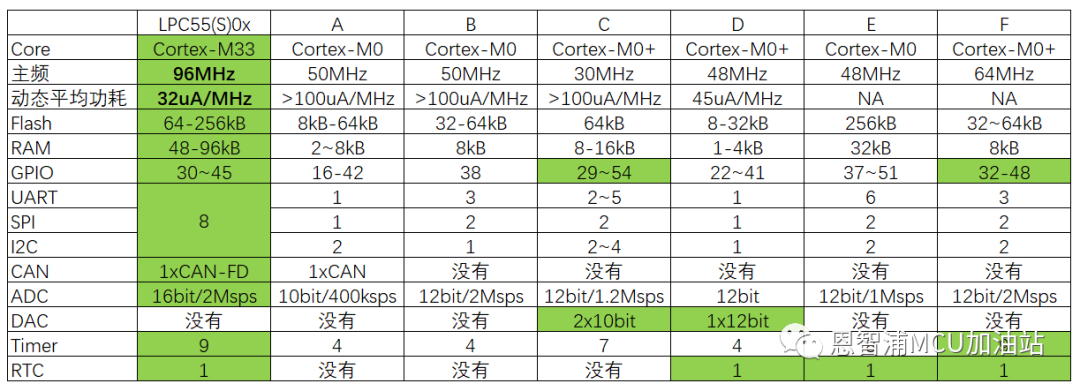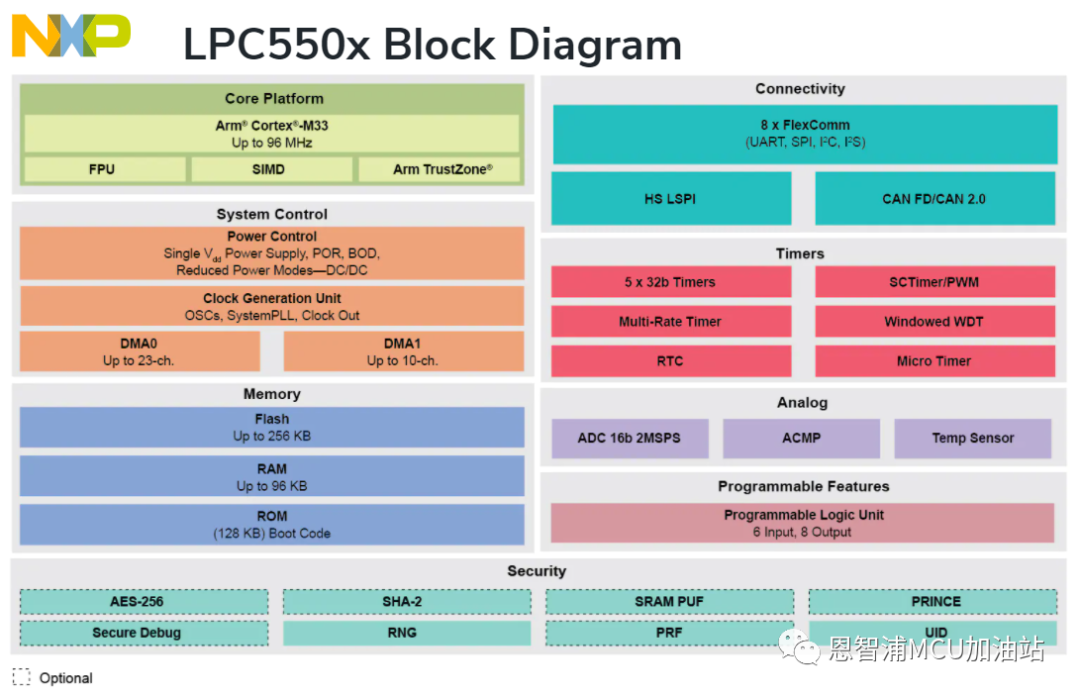
NXP has launched the smallest member of the LPC55 series MCU family, the LPC55(S)0x series.
As the smallest sibling in the LPC55 series family, upon closer examination, you will find that the LPC55(S)0x indeed possesses some impressive capabilities. Especially when I saw the official reference price of $10 for the LPC55(S)0x, I couldn’t help but marvel at how this Cortex-M33 is being sold at the price of a Cortex-M0+!So, I checked the official website for MCUs priced around $0.9 to $1.1, and unsurprisingly, there were no comparable Cortex-M0+ general-purpose products in that price range against the LPC55(S)0x.The LPC55(S)0x is similar to the classic LPC213x and LPC214x series, with the main difference being the presence of a USB interface (the LPC55(S)0x does not have USB, only retaining CAN or CAN-FD interfaces).Here is a simple comparison chart of features with Cortex-M0+ products:
(Tip: Click to view larger image)

Have you noticed that in this price range, the LPC55(S)0x is quite powerful?
The LPC5502JHI48 is the cheapest in the LPC55(S)0x series, so let’s start analyzing how this MCU challenges the older Cortex-M0+.
On-chip Flash and RAM basically features 64kB of on-chip Flash and 48kB of RAM (the LPC55(S)0x series has a maximum of 256kB Flash and 96kB RAM), which is already superior to other M0+ core products in terms of RAM capacity alone, making it the top configuration among other M0+ series products.Clock frequency, core, and performanceThe clock frequency is the most intuitive; the LPC55(S)0x has a maximum clock frequency of 96MHz, while the highest clock frequency of similar Cortex-M0+ products is only 72MHz.The CoreMark score for the Cortex-M33 core is 4.02, while the CoreMark score for the Cortex-M0+ core is 2.46. In simple terms, the Cortex-M33 core has very strong computational performance and a richer instruction set.Power consumptionThe dynamic power consumption of the LPC55(S)0x is around 32uA/MHz, similar to the entire LPC55 series, which is about one-third of the normal Cortex-M0+ products. This value is also very advantageous for some low-power applications of Cortex-M0+ products, such as those in column D of the comparison table.Rich serial interfacesThis point is self-explanatory; Cortex-M0+ products in the same price range generally have only 2-4 serial ports, while the LPC55(S)0x inherits the characteristics of the LPC55 series, featuring 7-8 Flexcomm interfaces (7 for HVQFN48 packaging and 8 for HTQFP64 packaging), allowing for up to 8 serial ports, which is a significant advantage.
Additionally, there are CAN or CAN-FD interfaces as options, which should please industrial customers who need CAN.
ADCIn terms of analog peripherals, the LPC55(S)0x does not have an on-chip DAC, but its ADC has been enhanced, with the bit depth reaching 16 bits and the sampling rate improved to 2Msps, up from 1Msps of its older brother, the LPC55(S)6x.ヾ(●´∇`●)ノ Wow~After reading this, do you feel that the LPC55(S)0x, this 40nm young MCU, is quite capable, facing its predecessors without any sneak attacks?At this point, I am not sure how to further introduce it. As a simple, general-purpose, and easy-to-use MCU, the LPC55(S)0x is derived from the LPC55(S)1x, lowering the maximum clock frequency and removing the USB interface that not everyone needs, making it more versatile and cost-effective (isn’t the precision of this approach impressive?). Here is a block diagram of the LPC55(S)0x architecture; for specific details, you can refer to my previous article on the LPC55(S)1x, which was about supporting bicycles. (Source: NXP)


1.Review of Domestic RISC-V Core MCU Manufacturers!
2. The Economic Development of the Embedded Industry and the Barometer of EU Industrial Development, Have You Been Paying Attention?
3. What is the Cost of Losing a Technical Employee?
4. A New World, A New Way: The 2021 International Embedded Exhibition and Conference Goes Digital
5. Analyzing the Design of Domestic Linux Operating System Architecture?
6. Introduction to Artificial Intelligence: Neural Networks Based on Linux and Python

Disclaimer: This article is a network reprint, and the copyright belongs to the original author. If there are any copyright issues, please contact us, and we will confirm the copyright based on the materials you provide and pay for the manuscript or delete the content.